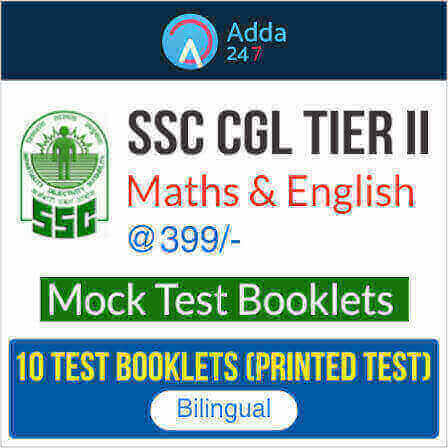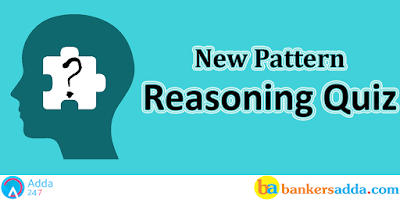Dear Readers,
The reasoning is a game of wits and presence of mind! Yes, it is true and it might seem as the greatest of the challenge after English Section’s surprises but yet this one can easily be dealt with. You just need correct practice and hardwire your brain to quickly make decisions about what to attempt and what to leave. And for same we are providing you questions of Reasoning Question and Answers. Solve these to Practice latest pattern reasoning question for bank exams.
Directions (1-5): These questions are based on the following letter/number/symbol arrangement. Study it carefully and answer the questions.
Z $ 3 H @ 8 B 1 # A 7 C L J U 5 K * E W I 2 F % T
Q1. If all the vowels in the above arrangement are replaced by the letter following it in the English alphabetic series, how many alphabets will appear twice in the given arrangement?
(a) None
(b) One
(c) Two
(d) Three
(e) More than three
Q2. Which of the following elements is the sixth to the right of fourteenth from the right?
(a) 8
(b) #
(c) J
(d) E
(e) None of these
Q3. How many such numbers are there in the above arrangement, each of which is immediately preceded by a vowel and also immediately followed by a consonant?
(a) None
(b) One
(c) Two
(d) Three
(e) More than three
Q4. Four of the following five are alike in a certain way based on their position in the above arrangement and so form a group. Which is the one that does not belong to the group?
(a) BA#
(b) #7A
(c) 5*K
(d) W2I
(e) 3@H
Q5. If the first eight digits/symbols/letters from the left are interchanged in a way that the first component is exchanged with the eighth, the second with the seventh and so on, which of the following would be the sixth from the left?
(a) @
(b) 3
(c) H
(d) B
(e) None of these
Directions (6-10): In each of the questions below are given four statements followed by four conclusions numbered I, II, III and IV. You have to take the given statements to be true even if they seem to be at variance from commonly known facts. Read all the conclusions and then decide which of the given conclusions logically follows from the given statements disregarding commonly known facts.
Q6. Statements: Some pens are rooms. All rooms are walls. Some walls are bricks. All bricks are slates.
Conclusions:
I. Some slates are walls.
II. Some walls are pens.
III. Some bricks are rooms.
IV. Some slates are rooms.
(a) Both I and III follow
(b) Both II and III follow
(c) Both I and II follow
(d) Both III and IV follow
(e) None of these
Q7. Statements: Some chairs are pencils. Some pencils are bottles. Some bottles are bags. Some bags are books.
Conclusions:
I. Some books are pencils.
II. Some bottles are chairs.
III. No book is pencil.
IV. Some bags are chairs.
(a) Only I follows
(b) Either I or III follows
(c) Only III follows
(d) Only IV follows
(e) None of these
Q8. Statements: Some roads are buses. All buses are trains. Some trains are trucks. All trucks are kites.
Conclusions:
I. Some trucks are roads.
II. Some kites are buses.
III. Some trains are roads.
IV. Some kites are trains.
(a) None follows
(b) Only I follows
(c) Only II follows
(d) Only III follows
(e) None of these
Q9. Statements: All beads are rings. All rings are bangles. All bangles are tyres. All tyres are pendants.
Conclusions:
I. Some pendants are beads.
II. Some tyres are rings.
III. Some bangles are beads.
IV. Some pendants are rings.
(a) Both I and II follow
(b) Only I, II and III follow
(c) Only II, III and IV follow
(d) Only I, III and IV follow
(e) All follow
Q10. Statements: Some desks are fruits. All fruits are flowers. No flower is branch. Some branches are roots.
Conclusions:
I. Some roots are flowers.
II. No desk is branch.
III. Some flowers are desks.
IV. Some branches are desks.
(a) Only either II or IV follows.
(b) Only III follows
(c) Both Either II or IV and III follow
(d) Both III and IV follow
(e) None of these
Directions (11-15): Study the following information carefully and answer the given questions:
In a certain code language ‘milk is very tasty’ is written as ‘ta la ja sa’, ‘tea is black’ is written as ‘ha ja ka’ and ‘sweet milk and tea’ is written as ‘ha pa sa ra’.
Q11. What is the code for ‘milk’?
(a) ja
(b) la
(c) sa
(d) pa
(e) None of these
Q12. ‘black tea’ can be coded as
(a) ha ja
(b) ka ha
(c) pa ha
(d) Can’t be determined
(e) None of these
Q13. Which of the following is coded as ‘ta’?
(a) very
(b) sweet
(c) Either tasty or very
(d) black
(e) None of these
Q14. Which of the following is the code for ‘black’?
(a) ra
(b) pa
(c) Either sa or ka
(d) ka
(e) None of these
Q15. ‘ja’ is the code for
(a) milk
(b) and
(c) is
(d) tasty
(e) None of these
You May also like to Read:
- More questions on Reasoning for Bank exam
- Reasoning ability study notes and tips
- IBPS Clerk Admit Card 2017




 Reasoning Quiz For Bank Foundation 2024 ...
Reasoning Quiz For Bank Foundation 2024 ...
 Reasoning Quiz For Bank Foundation 2024 ...
Reasoning Quiz For Bank Foundation 2024 ...



